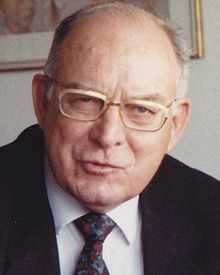Manfred R. Schroeder

Manfred Robert Schroeder (12 July 1926 – 28 December 2009) was a German physicist, most known for his contributions to acoustics and computer graphics. He wrote three books and published over 150 articles in his field.[1][2]
Born in Ahlen, he studied at the University of Göttingen (1947–52), earning a vordiplom in mathematics (1951) and Dr. rer. nat. (1954) in physics. His thesis showed how small regular cavities in concert halls cause unfortunate resonances.
He joined the technical staff at Bell Labs in New Jersey (1954-) researching speech and graphics, securing forty-five patents. With Bishnu Atal he was a promotor of linear predictive coding (1967). Still affiliated with Bell, he rejoined University of Göttingen as Universitätsprofessor Physik (1969) becoming professor emeritus (1991).
With B.S. Atal he developed code excited linear prediction (1985). He led a famed study of 22 concert halls worldwide, leading to a comparison method requiring no travel. He was visiting professor at University of Tokyo (1979).
Books
- Number Theory in Science and Communication: With Applications in Cryptography, Physics, Biology, Digital Information, and Computing (Springer-Verlag, 1983).
- Fractals, Chaos, Power Laws: Minutes from an Infinite Paradise (Freeman, 1991)
- Computer speech recognition, compression, synthesis (Springer-Verlag, 1985). With H. Quast and H. W. Strube
- Hundert Jahre Friedrich Hund: Ein Rückblick auf das Wirken eines bedeutenden Physikers (1996)
Awards and honors
- 1969 First Prize at the International Computer Art Competition for his application of concepts from mathematics and physics to the creation of artistic works.
- fellow of the Acoustical Society of America
- IEEE Fellow (1971).[3]
- Audio Engineering Society fellow and Gold medalist (1972)
- Member of the United States National Academy of Engineering (1979), for "founding the statistical theory of wave propagation in multi-mode media and contributions to speech coding and acoustics".[4]
- Fellow of the American Academy of Arts and Sciences (1986).[5]
- Helmholtz Medal of the German Acoustical Society
- 1975 Max Planck Society appointed foreign scientific member
- New York Academy of Sciences member 1978
- Rayleigh Medal 1984 and 1987
- Gold Medal from the Acoustical Society of America (1991), for "theoretical and practical contributions to human communication through innovative application of mathematics to speech, hearing, and concert hall acoustics".[6][7]
- ISCA Medal for Scientific Achievement from the International Speech Communication Association (2004).[8]
- Technology Award from the German Eduard Rhein Foundation (2004).[9][10]
References
- ↑ homepage.
- ↑ Interviews from IEEE history archive.
- ↑ Schroeder, M. (1981). "Direct (nonrecursive) relations between cepstrum and predictor coefficients". IEEE Transactions on Acoustics, Speech, and Signal Processing 29 (2): 297–301. doi:10.1109/TASSP.1981.1163546.
- ↑ "NAE Members Directory - Dr. Manfred R. Schroeder". United States National Academy of Engineering. Retrieved June 3, 2011.
- ↑ "Book of Members, 1780-2010: Chapter S". American Academy of Arts and Sciences. Retrieved June 3, 2011.
- ↑ "Acoustical Society of America Awards, Gold Medal". Acoustical Society of America. Retrieved June 3, 2011.
- ↑ "Gold Medal Award - 1991, Manfred R. Schroeder". Acoustical Society of America. Retrieved June 3, 2011.
- ↑ "ISCA Awards". International Speech Communication Association. Retrieved June 5, 2011.
- ↑ "Award Winners (chronological)". Eduard Rhein Foundation. Retrieved June 5, 2011.
- ↑ "Technology Award 2004 - Prof. Dr. Manfred Robert Schroeder". Eduard Rhein Foundation. Retrieved June 5, 2011.
|